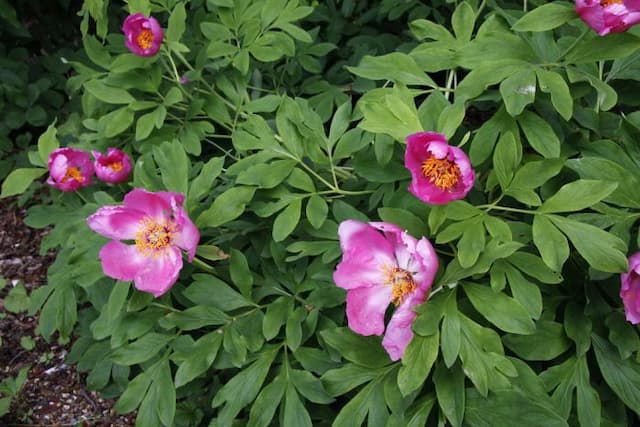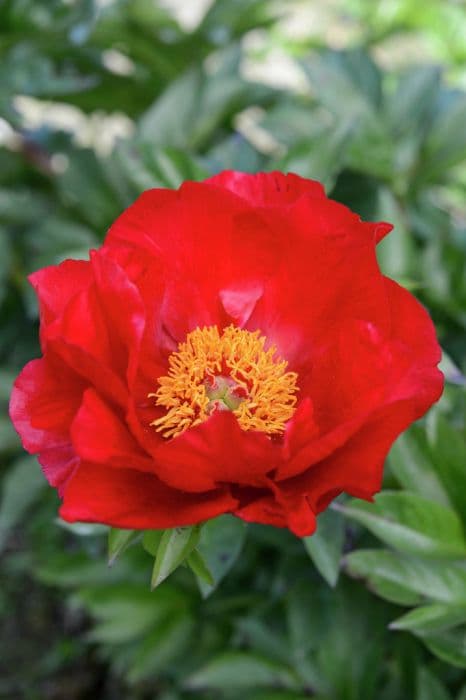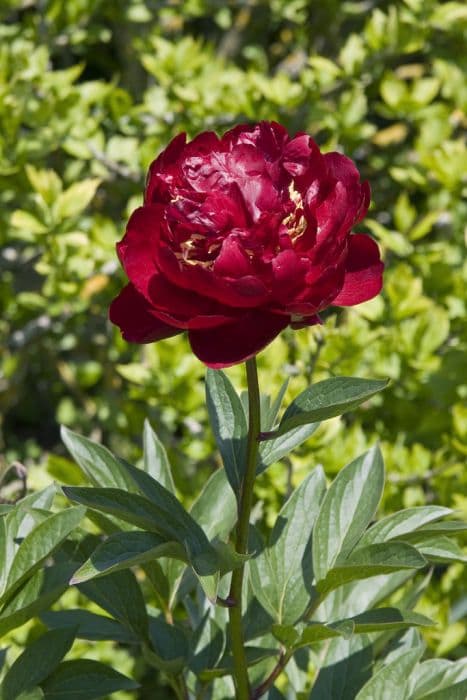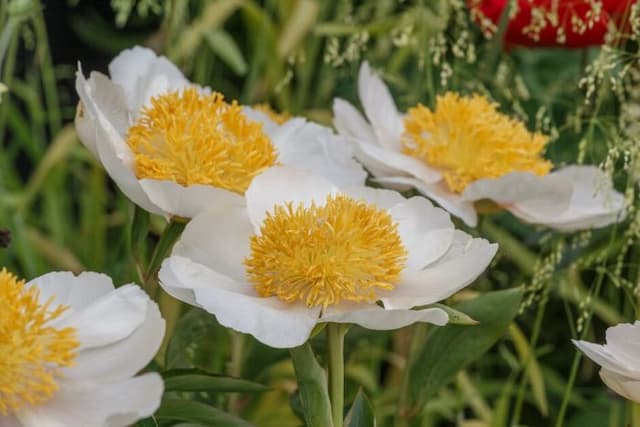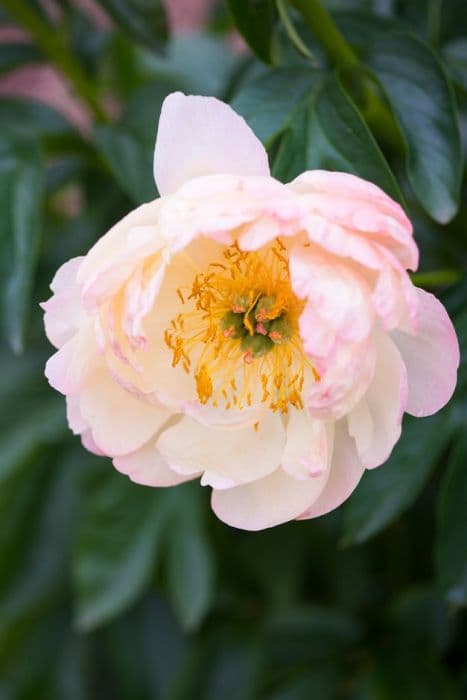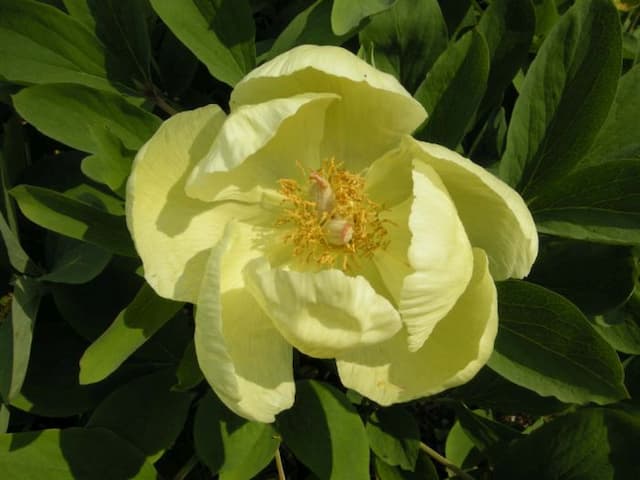Peony Paeonia mascula

ABOUT
The Paeonia mascula, widely known as the common peony, is a striking flowering plant that exudes an old-world charm. This perennial plant features a set of deeply lobed leaves, which are broad and have a lush green color that makes a pleasing backdrop for its flowers. The foliage can be quite bushy, providing a full and robust look even when the plant is not in bloom. The highlight of the common peony is undoubtedly its blossoms. These flowers are large and showy, composed of multiple layers of petals that can vary in color from a deep red to a pink or even white. The petals have a silky, soft texture that looks delicate but is surprisingly sturdy. They surround a center of yellow stamens which can be quite prominent, adding to the ornamental value of the flowers. Aside from its visual appeal, the common peony is also known for its delightful fragrance. The scent is subtle yet distinctly flowery, with a hint of sweetness that can be very appealing in gardens and indoor arrangements. Each individual flower is borne at the top of strong, erect stems, making them excellent as cut flowers that can stand proudly in a vase. After the blooming period, the common peony produces seed pods that extend its interest into the late season. These seed pods start out green and gradually turn to brown as they dry and ripen, splitting open to release the seeds. Overall, the common peony is revered for its sumptuous floral display and its ability to bring a traditional, yet timeless beauty to any setting where it's grown. It has an almost romantic quality that has secured its place in gardens for generations.
About this plant
 Names
NamesFamily
Paeoniaceae
Synonyms
Male Peony, Balkan Peony, Aegean Peony
Common names
Paeonia corallina var. mascula, Paeonia coriacea, Paeonia mascula subsp. mascula, Paeonia mascula subsp. arietina, Paeonia mascula subsp. bodurii, Paeonia mascula subsp. hellenica, Paeonia mascula subsp. russii, Paeonia mascula var. tomentosa, Paeonia mascula var. triternata, Paeonia tomentosa.
 Toxicity
ToxicityTo humans
The Paeonia mascula, commonly known as the peony, is not considered highly toxic to humans. However, all parts of the plant contain compounds that can be potentially toxic when ingested in large quantities. Symptoms of peony poisoning may include gastrointestinal upset, such as nausea, vomiting, and diarrhea. In some individuals, handling the plant may cause skin irritation due to its sensitivity to peony's compounds. It is always best to avoid ingesting any parts of the peony and to wash hands after handling the plant to prevent potential adverse effects.
To pets
The peony, commonly referred to as Paeonia mascula, is known to be toxic to pets, especially cats and dogs. If a pet ingests any part of the peony plant, it may suffer from gastrointestinal distress, including symptoms like vomiting, diarrhea, and possible drooling. In severe cases, ingesting significant amounts may lead to further complications such as depression or anorexia. It's important for pet owners to keep peonies out of reach and to contact a veterinarian if they suspect their pet has consumed any part of the plant.
 Characteristics
CharacteristicsLife cycle
Perennials
Foliage type
Deciduous
Color of leaves
Green
Flower color
Red
Height
2 feet (60 cm)
Spread
2 feet (60 cm)
Plant type
Herb
Hardiness zones
7
Native area
Mediterranean
Benefits
 General Benefits
General Benefits- Ornamental Value: Paeonia mascula, commonly known as peony, is highly valued for its large, showy flowers that add aesthetic appeal to gardens and landscapes.
- Attracts Pollinators: The flowers of the peony provide nectar and pollen for bees and other pollinators, supporting local ecosystems.
- Cultural Significance: Peonies have been culturally significant in many parts of the world, symbolizing wealth, honor, and prosperity, as well as love and happiness.
- Diversity in Landscaping: With various colors and forms, peonies offer a wide range of options for gardeners looking to diversify their landscape design.
- Longevity: Peonies are long-lived perennials, some living for over 100 years, providing a lasting addition to gardens.
- Seasonal Interest: Peonies bloom in late spring to early summer, offering seasonal interest and bridging the gap between spring bulbs and summer flowers.
- Low Maintenance: Once established, peonies require relatively little care, making them ideal for gardeners seeking low-maintenance plants.
- Deer Resistance: Peonies are generally resistant to deer, which can help protect gardens in areas with large deer populations.
- Historical Use in Breeding: Peonies have been extensively bred and hybridized, giving rise to a wide array of cultivars with desirable traits.
 Medical Properties
Medical Properties- Anti-inflammatory: Paeonia mascula has been traditionally used to reduce inflammation.
- Analgesic: It has properties that may help alleviate pain.
- Antispasmodic: The plant may provide relief from muscle spasms.
- Emmenagogue: Paeonia mascula might be used to stimulate menstrual flow.
- Hepatoprotective: There is some evidence suggesting it may protect the liver.
- Immunomodulatory: It might have effects on regulating the immune system.
 Air-purifying Qualities
Air-purifying QualitiesThis plant is not specifically known for air purifying qualities.
 Other Uses
Other Uses- Paeonia mascula, also known as the male peony, has been traditionally used in the tanning of leather due to the presence of tannins in its roots.
- The flowers of the male peony can be pressed and used in artwork for their natural pigmentation, providing a delicate touch to handmade papers and crafts.
- The seed oil extracted from the male peony can be incorporated into natural cosmetics as a moisturizing agent thanks to its emollient properties.
- In garden landscapes, the male peony is utilized for its hardiness and ability to deter certain pests, thus serving a protective role for nearby more vulnerable plants.
- The male peony's large, colorful blossoms are sometimes used in floral water infusions to add fragrance to baths or homes without using synthetic perfumes.
- Select parts of Paeonia mascula may be used in natural dyeing processes, imparting subtle hues to fabrics and yarns.
- Due to their distinct appearance, the blooms are often incorporated in the photography and film industries as symbolic props or to enhance visual storytelling.
- The sturdy stems of the male peony can be gathered and used in some traditional construction applications, such as making natural fences or trellises.
- The discarded petals and plant material post-bloom can be composed to enrich soil as a nutrient-rich mulch that promotes the growth of other plants.
- In some cultures, the male peony is used in culinary presentations, with the non-toxic petals being used to decorate dishes and add an element of natural beauty.
Interesting Facts
 Feng Shui
Feng ShuiThe Peony is not used in Feng Shui practice.
 Plant Symbolism
Plant Symbolism- Prosperity: Peonies are often associated with wealth and success, making them symbolize prosperity.
- Romance: Due to their full, rounded blooms, peonies symbolize romantic love, often used in weddings.
- Honor: They can represent honor and high esteem, possibly owing to their use in imperial China.
- Beauty: With their lush petals, peonies are seen as a symbol of beauty and feminine charm.
- Good Fortune: Peonies are believed to bring good luck, making them a common gift to wish someone well.
- Compassion: Their soft, generous appearance can suggest a sense of compassion and nurturing.
 Water
WaterPeonies like Paeonia mascula need to be watered deeply about once a week, ensuring the soil is moist but not waterlogged. During the growing season, especially if rainfall is less than 1 inch per week, supplement with additional water. Use about 0.5 gallons of water per plant for each watering session. Reduce watering after the blooms fade and as the plant prepares for dormancy in the fall. It's important to avoid wetting the foliage directly to prevent fungal diseases, so water at the base of the plant.
 Light
LightPeonies such as Paeonia mascula thrive in full sun conditions with at least 6 to 8 hours of direct sunlight per day. They can tolerate light afternoon shade, especially in hotter climates, but too much shade will reduce blooming. The best spot for planting peonies is in a well-exposed garden bed away from competing trees and shrubs.
 Temperature
TemperaturePeonies like Paeonia mascula can tolerate a wide range of temperatures but prefer a temperate climate. They need cold winters with temperatures below 40°F for dormancy and to set buds, but should not be exposed to temperatures below -20°F. The ideal growing temperatures during the growing season range between 65°F and 75°F.
 Pruning
PruningPeonies like Paeonia mascula should be pruned to remove spent flowers and to shape the plant after blooming has finished. Pruning in the fall is important as well; remove all the foliage after the first frost and discard it to prevent disease. Pruning not only helps to maintain an attractive shape but also encourages healthy growth and airflow for the following season.
 Cleaning
CleaningAs needed
 Soil
SoilPeony thrives in a well-draining soil mix enriched with organic matter, at a pH of 6.5 to 7.0. A blend of loamy garden soil, compost, and perlite or coarse sand is ideal to ensure proper drainage and fertility for optimal growth.
 Repotting
RepottingPeonies, including the common peony, generally do not need to be repotted often as they prefer to be left undisturbed. They can be left in the same spot for many years, up to 10-15 years, provided the soil remains fertile and well-draining.
 Humidity & Misting
Humidity & MistingThe common peony prefers an outdoor environment and does not require high humidity, thriving in average atmospheric conditions. It is tolerant of a range of humidity levels commonly found outdoors.
 Suitable locations
Suitable locationsIndoor
Ensure ample sunlight and well-draining soil.
Outdoor
Plant in sun, use fertile, well-drained soil.
Hardiness zone
3-8 USDA
 Life cycle
Life cyclePaeonia mascula, commonly known as peony, begins its life cycle as a seed, which, when sown in soil, will undergo a period of dormancy before germination. After breaking dormancy, the seedling emerges, developing into a young plant with a small root system and a few leaves, which photosynthesize to provide energy for growth. Over the years, the plant matures and forms an increasingly large rootstock or tuber, which serves as an energy reserve, allowing the peony to survive winters and regrow each spring. The mature peony then produces buds that bloom into large, fragrant flowers typically in spring or early summer, displaying a range of colors depending on the variety. After pollination, which is often aided by insects attracted to the flowers, seed pods (follicles) develop, eventually releasing seeds to complete the life cycle. The plant enters a period of senescence in late summer after flowering, where foliage dies back, and the peony enters a state of dormancy until the next growing season.
 Propogation
PropogationPropogation time
Spring
Propogation: The most popular method of propagating Paeonia mascula, commonly known as the peony, is by division of its root system. This is best done in the fall, when the plant has become dormant. To propagate by division, carefully dig around the peony to lift the clump from the ground. Gently shake off loose soil and use a sharp knife or garden shears to divide the root mass. Each division should have at least 3-5 eyes, which are the pink or white buds that will become next year's shoots. Replant the divisions immediately, positioning the eyes about 2 inches (5 cm) below the soil surface and water in well. Successful division encourages rejuvenation of the plant and can lead to more vigorous growth and flowering in the following season.
